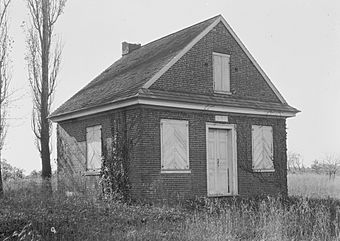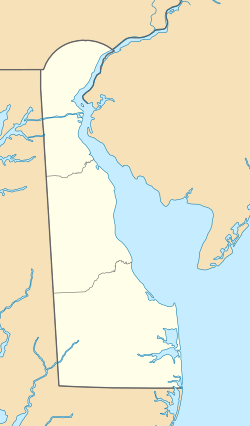Appoquinimink Friends Meetinghouse facts for kids
Quick facts for kids |
|
|
Appoquinimink Friends Meeting House
|
|
|
U.S. Historic district
Contributing property |
|

Meetinghouse in 1938
|
|
| Location | 624 Main St., Odessa, Delaware |
|---|---|
| Area | less than one acre |
| Built | 1785 |
| Part of | Odessa Historic District (1984 boundary increase) (ID84000846) |
| NRHP reference No. | 72000288 |
| Added to NRHP | December 04, 1972 |
The Appoquinimink Friends Meeting House, also called the Odessa Friends Meetinghouse, is a very old and special building in Odessa, Delaware. It is a Quaker meetinghouse, which is a place where Quakers gather for worship. Built in 1785, this small brick building has a big history. It might even be the smallest brick house of worship in the United States!
Contents
A Historic Quaker Meetinghouse
The Appoquinimink Friends Meeting House was built in 1785 by David Wilson. It was added to the National Register of Historic Places in 1972. This means it is recognized as an important historical site. The building is quite small, measuring about 20 feet by 22 feet.
Quakers in Odessa
Quakers were among the first people to settle in the Odessa area. They are a religious group known for their peaceful beliefs. The first Quaker meetinghouse in this part of Delaware was started in 1763. Later, in 1781, the Quakers decided to move their meeting place to Appoquinimink Bridge, which is now Odessa.
Early Quaker School
A Quaker school was set up in Appoquinimink even earlier, in 1735. This school likely taught children until the mid-1800s. The school building was later moved and eventually taken down.
Building the Meetinghouse
David Wilson built the current meetinghouse around 1785. However, the building and its land were not officially given to the Quaker Meeting until 1800. Interestingly, David Wilson and his wife were temporarily not allowed to attend Quaker meetings because they did not get married in a Quaker ceremony.
A Stop on the Underground Railroad
The Appoquinimink Friends Meeting House played a secret and very important role in history. Many Quakers who met here were active in the Underground Railroad. This was a secret network that helped enslaved people find freedom.
Helping Others to Freedom
Important members of the meeting, like John Hunn, helped many people escape slavery. John Hunn and another helper, Thomas Garrett, were even arrested and fined for their brave actions. It is believed that Harriet Tubman, a famous leader on the Underground Railroad, might have hidden in this meetinghouse.
Secret Hiding Places
The meetinghouse had secret spots that could have been used to hide people seeking freedom. These included the basement and a loft with a removable panel under the roof.
Changes and Restoration
Over the years, the meetinghouse faced some challenges.
A Split in the Quaker Community
In 1828, the Quaker community experienced a big split, which reduced the number of members at the Appoquinimink Meeting. Many families started attending other Quaker meetings.
Decline and Revival
By the early 1870s, John Alston was the last active member of the meeting. After he passed away in 1874, the meetinghouse started to fall apart. For a while, it was even rented out to local farmers.
Restoration and Continued Worship
In 1938, the building was restored by H. Rodney Sharp. It reopened for worship in 1939, and a new Appoquinimink congregation was formed in 1948. Today, the meetinghouse continues to be used for worship regularly, meeting twice a month.
The Burial Ground
Behind the meetinghouse is a burial ground. It has many different types of markers, from simple fieldstones for early Quakers to more modern gravestones. This is where many Quakers from the community were laid to rest.
See also



